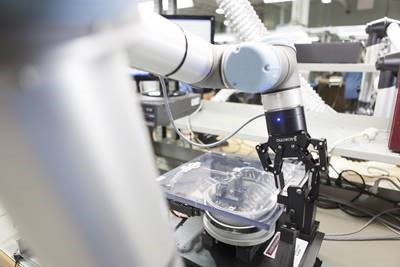At this point, we need to discuss the strengths and limitations of process automation with collaborative robots.
Getting Started with Collaborative Robots - Part 2 - How to Identify Potential Processes for Automation
Contributed by | Robotiq
At this point, we need to discuss the strengths and limitations of process automation with collaborative robots.
In fact, you probably already have a bunch of ideas as to what processes you would like to have automated. I am afraid to say that most of the tasks you thought were good candidates for automation are probably not the best choices to begin with. We need to be realistic about what the technology can do today. Some applications are easier to automate than others and as a first integration you should start small and simple.
Ideal tasks for a first collaborative robot are tasks that are highly predictable and repeatable. These are easiest to automate with a collaborative robot.

Tasks that are highly repetitive, predictable and structured are the easiest to automate with a collaborative robot.
Here's an overview to get you thinking:
Easy to automate
- Repetitive tasks not requiring the robot to apply force
- Pick and place
- Dispensing
- Part presentation
- Little part changeover or changeover among similar parts
- Always picked in the same place
- Ordered parts and workpieces
- If many parts, structured in a matrix or tray
- Part drop-off
- Always dropped in the same place
- Always dropped in the same place
Harder to automate
- Complex logic or decision making
- Sensors
- Vision
- Force torque sensor
- Parts
- High changeover rates of parts with divergent properties (size, shape)
- Deformable parts
- Part presentation
- Moving conveyors
- Unstructured presentation (bins)
- Integrating communication with other machines
- Force controlled processes
- Grinding
- Polishing
- Drilling
- Fine assembly
- Processes requiring specialized tools or human know-how
- Welding
- Painting
Tip: To create a quick simulation, perform the task and think about whether you could do the same task without seeing or feeling the part, its weight or the force applied by the part. In other words, could you do it blind? This will give you an indication of what kind of sensors you will need.
ROBOTIQ MAKES TOOLS FOR AGILE AUTOMATION
 Robotiq’s mission is to free human hands from tedious tasks so companies and workers can focus where they truly create value.
Robotiq’s mission is to free human hands from tedious tasks so companies and workers can focus where they truly create value.
Our grippers and sensors enhance robot application flexibility and integration simplicity.
Our products are sold and supported in more than 30 countries, through a network of highly capable channel partners.
The content & opinions in this article are the author’s and do not necessarily represent the views of RoboticsTomorrow
Featured Product

